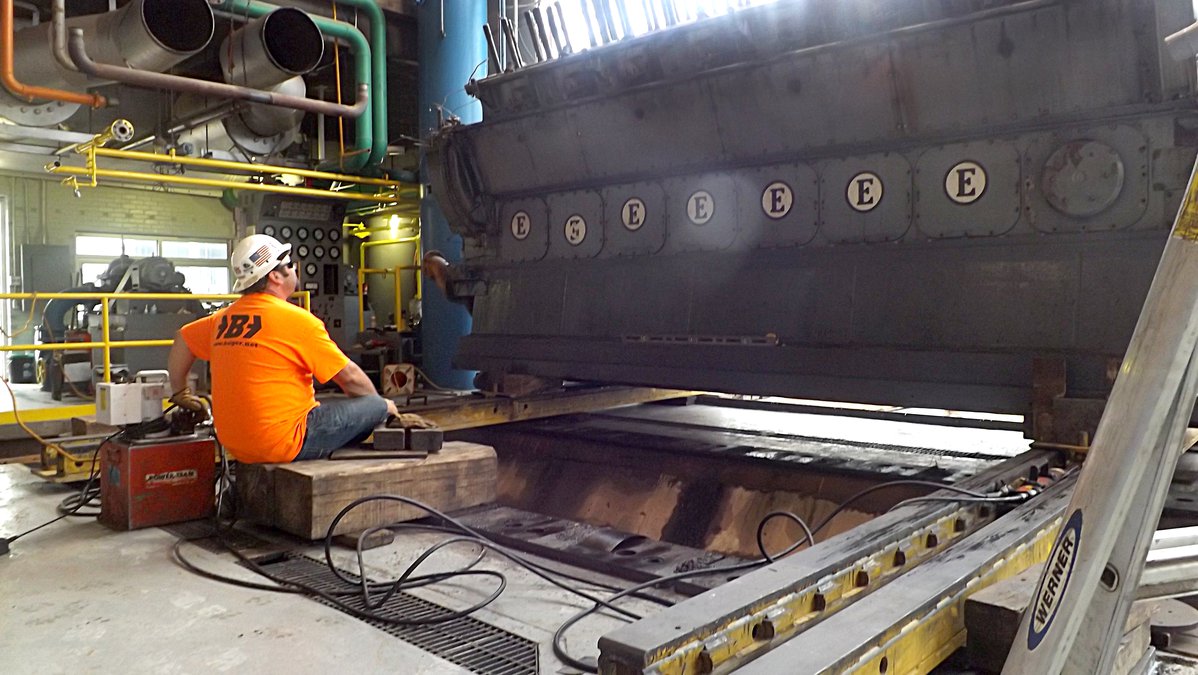HOISINGTON — The Hoisington Municipal Power Plant is a step closer to firing up its massive new engine this week.
Late last week, workers from Belger Cartage Service, based in Kansas City, Mo., completed the arduous process of removing the old 90-ton No. 8 engine from inside the plant to make room for the new engine.
Thursday morning, workers used a crane to lift the mammoth 40-year-old Enterprise engine onto skids where two large hydraulic presses pushed the engine out at about speed of about 20 feet per hour, according to plant mechanic Darren Delzeit.
Later in the day, plant employees spent time removing more equipment from the basement to make room for the new engine, a 2009 Electro-Motive Diesel (EMD) Model 710 engine, which plant supervisor Shane Andereck expected to arrive from Houston, Texas, sometime early this week, hopefully late Monday or early Tuesday. The new engine tips the scales at a comparatively light 70 tons, or about 140,000 pounds.
Earlier in the week, workers from Belger used a crane to lift the engine from its place in the basement of the plant, and onto the hydraulic skids. An older generator attached to the engine was removed earlier in the week.
Once removed, both the old engine and the old generator will be hauled on special flatbed trailers to area scrap yards.
The generator had initially been sold, but the Andereck said the prospective buyer failed to make minimum payments, so the generator will be transported to a scrap yard in Wichita where the city will sell it for parts. The old engine will be taken to Acme Scrap in Great Bend.
When the new engine arrives, Belger will also do the work to get the new engine into the building.
To even get the old engine out of the building, though, an entire section of the south wall of the power plant had to first be taken down.
Early in the week, crews from Jimlo Glass in Great Bend took the existing windows out, while Scott A. Christians Construction LLC from Hoisington completed the work to remove the remainder of the wall. The Hoisington company was the low bid on that portion of the project. Andereck said the next lowest bid would have been almost three times the cost.
Scott A. Christians Construction will also do the work to rebuild the wall once the new engine has been moved into the building and installed. Andereck said the goal was to have as much of the wall as possible back in place by the Independence Day holiday.
Once the new engine is installed, Delzeit said it will likely be another few months before it is operational, because there are several steps in getting it up and running. Several more accessories must be hooked up to the engine at the plant, as well as getting the engine connected to the substation.
Brief history
These are the next steps in a process which began in October 2020, when the Hoisington City Council approved measures to replace the old engine, which Andereck said was becoming too cost prohibitive to keep operational.
“As it gets older it gets harder to find parts for it and the parts get more and more expensive,” he said. “The engine we’re putting in is more modern, and it’s more cost efficient to run.”
At the time the project was approved, Andereck said the new 900 RPM, 20-cylinder engine would allow the plant to increase its automation capabilities.
“This plant is still very much old school,” Andereck said at the time. “There’s still switches to be thrown, knobs to be turned and buttons to be pushed. But with this unit upgrade we will now have the ability to have the newer engine and the older engines working together because of the increased automation.”
From start to finish, the project was initially slated to be completed in roughly a year.





